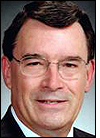Jul 06, 2007Starting in August, Slippery Rock University's 8,500 students and faculty members will each receive a passive 13.56 MHz RFID tag they can attach to their cell phones. This tag will allow them to pay for everything from laundry and copier services to movies and groceries in the surrounding town of Slippery Rock, located about 50 minutes north of Pittsburgh.
Payment card solutions company Heartland Payment Systems is providing the RFID system, which uses near-field communication (NFC) technology and complies with the ISO 14443 standard.
Slippery Rock students can currently make purchases by means of photo ID cards, which contain a magnetic stripe encoded with each user's ID number. The students already use their ID cards to pay for goods and services at the school. Upon enrolling at the university, students open a Rock Dollar FDIC-insured bank account, in which they (or their parents) can deposit spending money. The ID card's mag-stripe can be swiped at point-of-sale terminals or vending machines, with the money automatically deducted from the Rock Dollar account.
Students can go online at any time to track their spending and, if they so desire, allow their parents the same access. Their parents can then see where the money is being spent, and add money to the account.
The school is adopting the RFID system to enable students to spend money even if they leave their wallet and ID card at home. "We wanted to provide additional services to our students," says Robert Smith, president of Slippery Rock University, "and we've always taken a certain pride in the fact that we are technologically sophisticated on our campus." Prior to the deployment of the system, Smith spoke with Heartland' manager of IT, Barry Welsch, regarding a contactless payment solution. Welsch suggested one based on near-field communication.
The resulting solution will be available to students and faculty at the start of the fall semester, in conjunction with the ID cards. Supplied by RFID systems provider On Track Innovations (OTI), the tag is affixed to a cell phone, preferably on the inside cover of the battery compartment. When presented to an RFID interrogator at a merchant's sales terminal, it transmits an ID number linked to the tag holder's Rock Dollar account. Heartland is providing RFID-enabled point-of-sale terminals for deployment on the college campus. In addition, Welsch says, the company is signing up merchants in town, and also in neighboring communities.
At the first meeting with merchants, expected to take place next week, Welsch hopes to sign up 50 to 100 merchants initially. Whether on campus or off, he explains, the merchants must purchase the point-of-sale device, manufactured by VeriFone and cabled to an RFID interrogator and PIN keypad made by Heartland. The device will be able to read regular payment media, such as mag-stripe credit cards and student ID cards, as well as RFID tags in cell phones. Welsch estimates the cost of the device will be similar to that of a POS device without the reader: about $500. Merchants must use the specific VeriFone credit-card terminals, with an RFID reader and PIN pad attached. The devices can also accept Visa and MasterCard contactless cards.
Welsch reports that unattended food and beverage vending machines, clothes washers and driers, and photocopiers on campus will each have a Heartland RFID reader installed, which will communicate directly with Heartland's host system via an Internet connection. Dining halls, the bookstore and other on-campus merchants will use VeriFone POS terminals, in combination with the Heartland interrogators and PIN keypads.
According to Welsch, initial interest from Slippery Rock-area merchants has been enthusiastic. Heartland has built the technology and has also provided RFID tags for some university summer-school students. During the fall semester, it is prepared to distribute the tags to all students. The company is also installing 122 readers in vending, laundry and photocopy machines, as well as at on-campus retail facilities.
Although the vendor declines to disclose the price Slippery Rock pays for the RFID tags, Welsch points out that RFID cards and tags typically cost about $1 apiece. The university will make the cards and tags available for free to all its students.
"In the focus-group research, we found that students considered their cell phone a device they would always have with them, and which they expected greater use from," Smith says. "Originally, we thought of embedding the tags in the phone, but decided to give the plastic card [the existing ID card with mag-strip and photo] and a separate chip with the intent to attach to the phone." (Technology is not yet available or affordable that would allow the tag to replace the card.) Students use the picture on the card, for example, to verify their identity.
Smith says he already has the chip attached to his own phone, and fully expects most of the faculty and students to do the same. "We already know students are incredibly excited about this," he states. "We found students want to be able to make a statement about Slippery Rock [and its technology]." By using their phones to make payments in public places, Smith adds, they are making that statement to students of other public universities, who must dig cash or credit cards out of their wallets.


